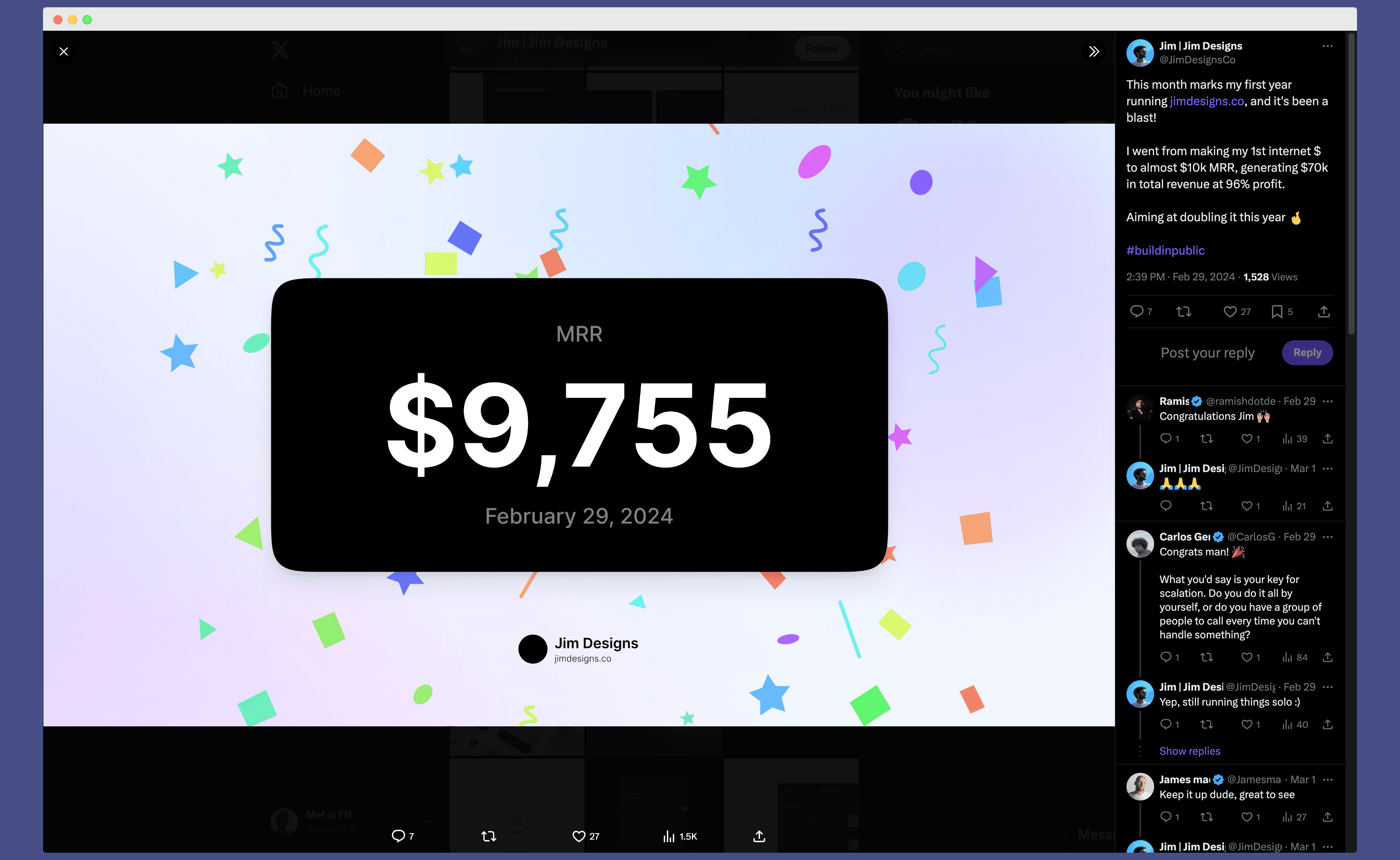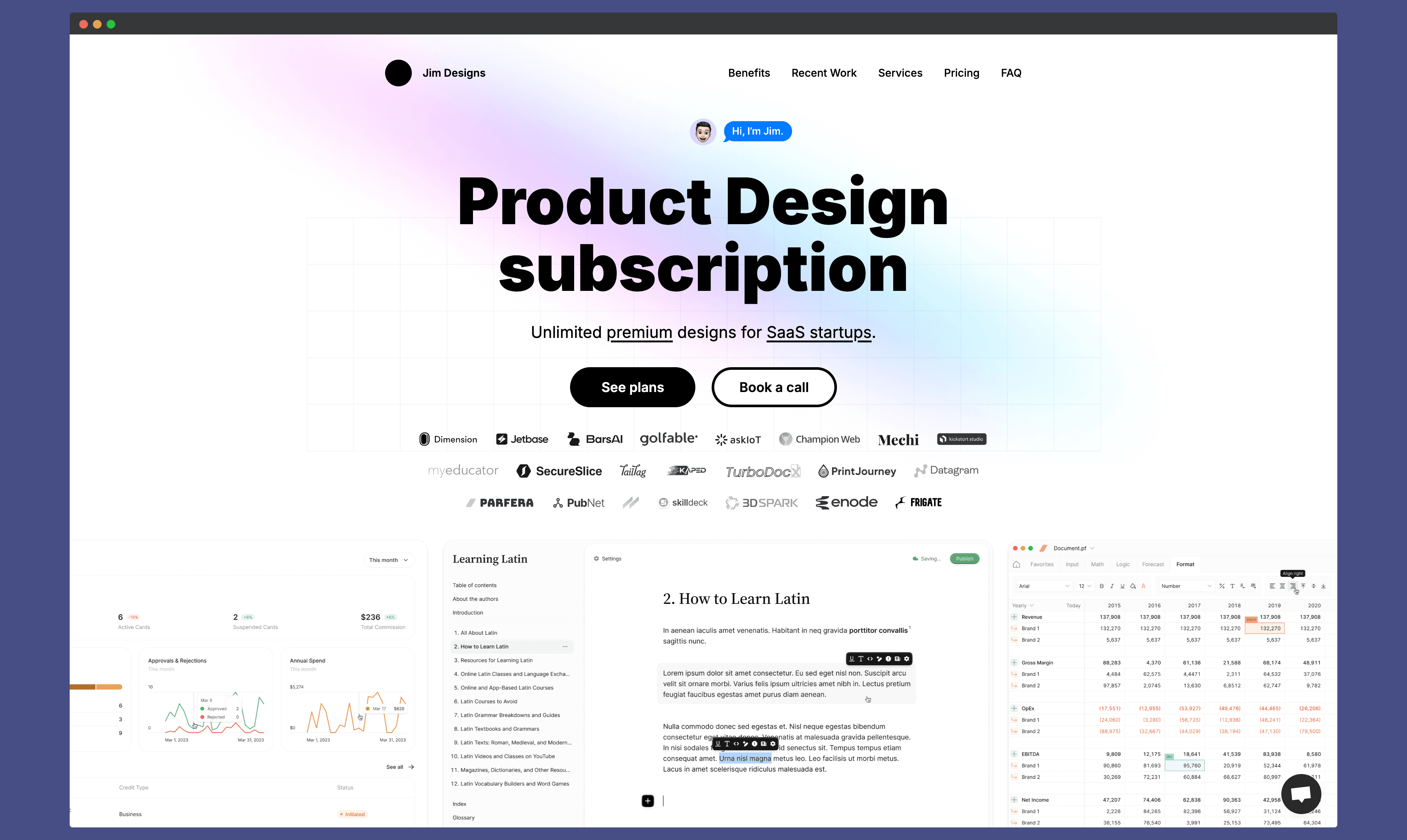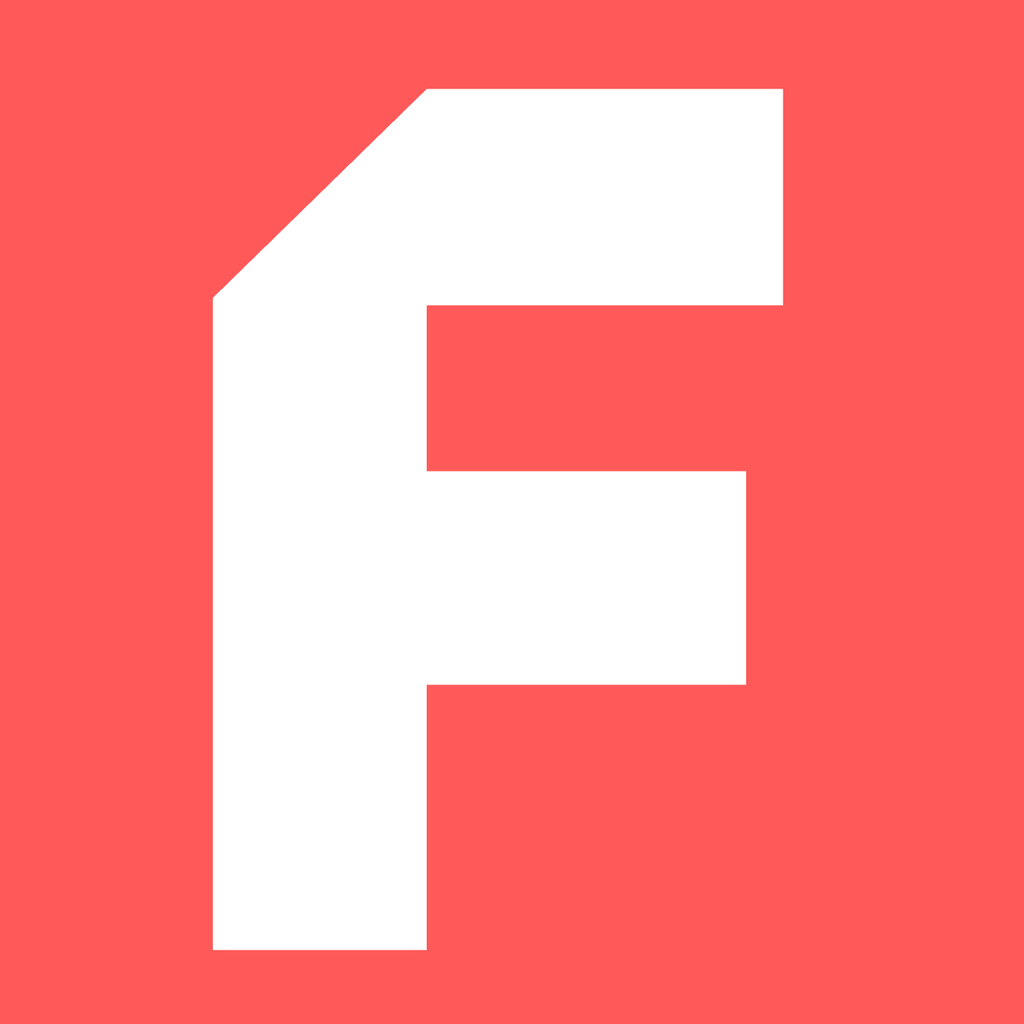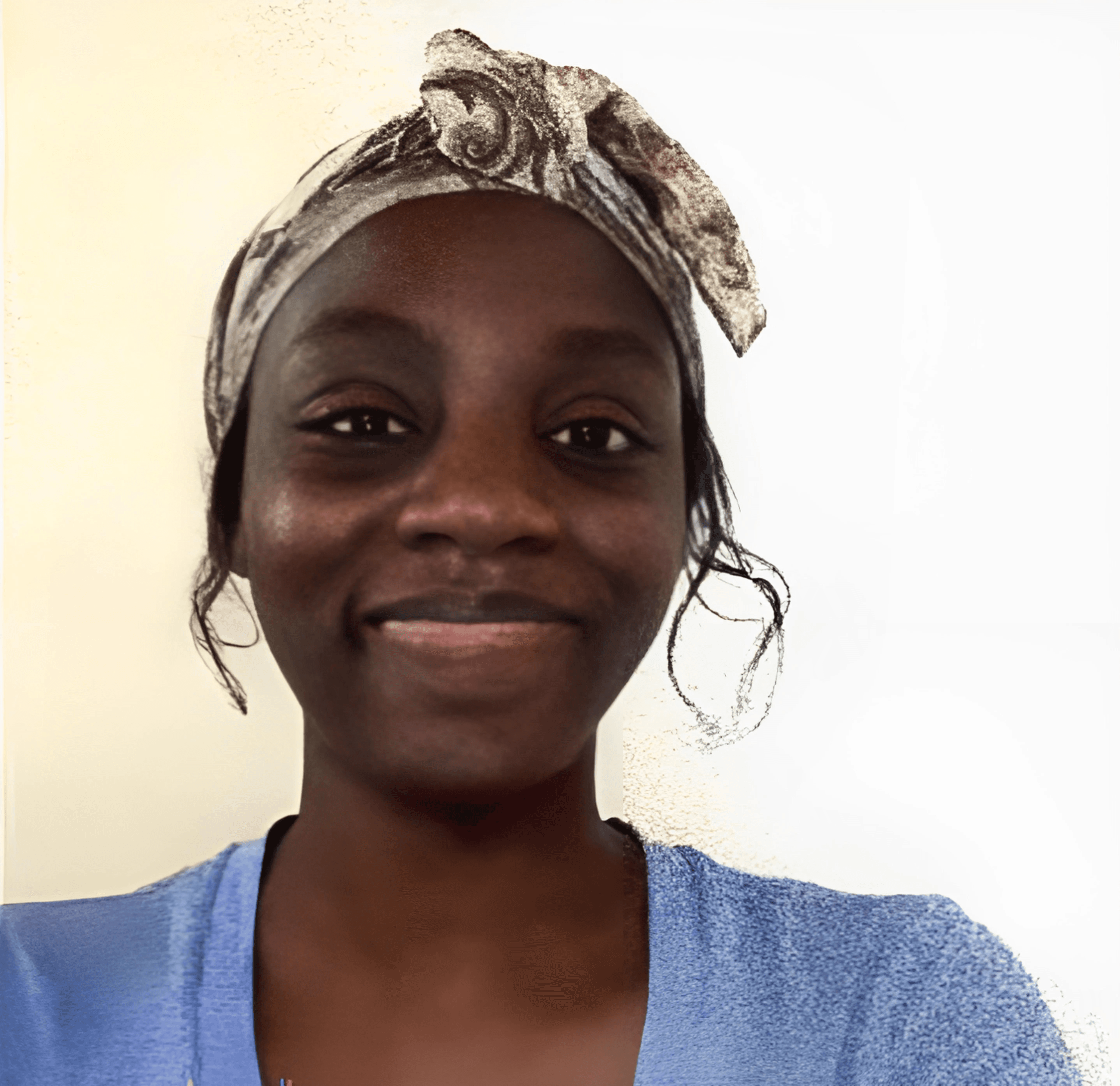How Jim Harrison Built a $9K MRR Product Design Productized-Sevice Business
How Jim Harrison Built a $9K MRR Product Design Productized-Sevice Business
Nov 10, 2024


Jim Harrison
Jim Harrison
⏳ 6 min
⏳ 6 min
Revenue/month
Revenue/month
$9,000
$9,000
$9,000
No. of founders
No. of founders
1
1
1
Startup costs
Startup costs
N/A
N/A
N/A
Company type
Company type
Company type
Productized-Service
Productized-Service
Productized-Service
Contents
Introduction
Introduction
Jim Harrison went from earning his first dollar online to $9,000 MRR, crossing the $100K revenue mark—all while keeping his day job. Here’s how Jim grew Jim Designs, his subscription-based design studio, and what he learned along the way.
(A screenshot of Jim Designs MRR posted by Jim On X)

Jim Harrison went from earning his first dollar online to $9,000 MRR, crossing the $100K revenue mark—all while keeping his day job. Here’s how Jim grew Jim Designs, his subscription-based design studio, and what he learned along the way.
(A screenshot of Jim Designs MRR posted by Jim On X)

Starting Out
Starting Out
Jim had a stable job and didn’t mind the employee life. But in 2020, he read Rich Dad, Poor Dad, a book that shifted his thinking. Relying only on a paycheck, Jim realized, was risky. Covid-19 and the wave of layoffs around him made it even clearer that he needed another source of income.
Looking for inspiration, Jim dove into content about financial freedom, spending hours on Indie Hackers, Product Hunt, and Twitter (now X), gathering insights and ideas.
Jim had a stable job and didn’t mind the employee life. But in 2020, he read Rich Dad, Poor Dad, a book that shifted his thinking. Relying only on a paycheck, Jim realized, was risky. Covid-19 and the wave of layoffs around him made it even clearer that he needed another source of income.
Looking for inspiration, Jim dove into content about financial freedom, spending hours on Indie Hackers, Product Hunt, and Twitter (now X), gathering insights and ideas.

















2,678+ people enjoy it
➤ Every week, we dig up stories of how regular people started and grew their businesses—
➤ Plus the marketing hacks that won them customers.
➤ Then, we share those insights with you.
➤ Every week, we dig up stories of how regular people started and grew their businesses—
➤ Plus the marketing hacks that won them customers.
➤ Then, we share those insights with you.
Learning from Failures and Finding His Niche
Learning from Failures and Finding His Niche
Jim’s initial ventures into the SaaS world didn’t go as planned. After a few unsuccessful attempts, he stumbled upon Brett from Designjoy. Seeing the potential of a productized service but wanting to make it unique, Jim decided to focus on product design only.
(A screenshot of JimDesigns landing page)

His takeaway? Leverage what you’re already good at. Trying to solve unfamiliar problems for an unknown audience would only make things harder. He knew product design and saw the demand for quality design was high but difficult to fulfill affordably.
Jim’s initial ventures into the SaaS world didn’t go as planned. After a few unsuccessful attempts, he stumbled upon Brett from Designjoy. Seeing the potential of a productized service but wanting to make it unique, Jim decided to focus on product design only.
(A screenshot of JimDesigns landing page)

His takeaway? Leverage what you’re already good at. Trying to solve unfamiliar problems for an unknown audience would only make things harder. He knew product design and saw the demand for quality design was high but difficult to fulfill affordably.
Taking the Leap: Launching Jim Designs
Taking the Leap: Launching Jim Designs
With confidence in his design skills, He launched Jim Designs in January 2023. His service? A simple model: clients pay a subscription fee and can request as many designs as they need, delivered one at a time, usually within two days.
The startup costs were low. Jim’s setup included:
A landing page he designed and coded himself
Minimal tools: Trello for task tracking and Figma for design work
Keeping it basic meant he could spend more time on marketing. This approach saved him from getting stuck in endless “building” and let him go live quickly.
With confidence in his design skills, He launched Jim Designs in January 2023. His service? A simple model: clients pay a subscription fee and can request as many designs as they need, delivered one at a time, usually within two days.
The startup costs were low. Jim’s setup included:
A landing page he designed and coded himself
Minimal tools: Trello for task tracking and Figma for design work
Keeping it basic meant he could spend more time on marketing. This approach saved him from getting stuck in endless “building” and let him go live quickly.
Building the Business Model
Building the Business Model
Jim’s subscription model, similar to SaaS, offered predictability. However, unlike a SaaS product, customer retention was shorter since most clients only needed design help for a couple of months. This means new client acquisition is crucial. He focuses on:
Referrals, a sign he’s delivering quality work
Building in public, which we’ll dive into next
Building in Public
Jim shares his journey, his struggles, and snippets of his designs online. Social media became his primary client source, as people appreciated seeing his transparent approach and his work. Sharing the personal side of his business gave people confidence that they knew who they’d be working with.
Referrals
Jim’s clients bring in others through word of mouth. Referrals are especially important in design, where trust in the designer's skill and reliability is everything.
Jim’s subscription model, similar to SaaS, offered predictability. However, unlike a SaaS product, customer retention was shorter since most clients only needed design help for a couple of months. This means new client acquisition is crucial. He focuses on:
Referrals, a sign he’s delivering quality work
Building in public, which we’ll dive into next
Building in Public
Jim shares his journey, his struggles, and snippets of his designs online. Social media became his primary client source, as people appreciated seeing his transparent approach and his work. Sharing the personal side of his business gave people confidence that they knew who they’d be working with.
Referrals
Jim’s clients bring in others through word of mouth. Referrals are especially important in design, where trust in the designer's skill and reliability is everything.
Timing and the Advantage of Being Early
Timing and the Advantage of Being Early
When Jim started Jim Designs, there weren’t many competitors in the subscription-based design studio space. Being one of the first gave him an edge to capture initial leads. Today, with more designers entering the market, establishing credibility is harder. However early entry allowed him to secure a client base and build a brand reputation before competition grew.
When Jim started Jim Designs, there weren’t many competitors in the subscription-based design studio space. Being one of the first gave him an edge to capture initial leads. Today, with more designers entering the market, establishing credibility is harder. However early entry allowed him to secure a client base and build a brand reputation before competition grew.
Pricing Strategy
Pricing Strategy
He started with a lower price point to build credibility. Despite the advice to “charge more,” Jim’s initial goal was client traction, not big profits. Over time, he raised his rates as demand grew. This approach allowed him to build trust and attract clients in a competitive space without needing a huge marketing budget.
He started with a lower price point to build credibility. Despite the advice to “charge more,” Jim’s initial goal was client traction, not big profits. Over time, he raised his rates as demand grew. This approach allowed him to build trust and attract clients in a competitive space without needing a huge marketing budget.
Delivering Value Above All
Delivering Value Above All
The foundation of Jim’s business is delivering high-quality designs at an accessible price. This simplicity—good designs, fast delivery, reasonable pricing—created a no-brainer value for clients. They could get designs that would typically cost far more in an agency setting.
He emphasizes: Focus on what people want. Providing value keeps clients happy and ensures they spread the word.
The foundation of Jim’s business is delivering high-quality designs at an accessible price. This simplicity—good designs, fast delivery, reasonable pricing—created a no-brainer value for clients. They could get designs that would typically cost far more in an agency setting.
He emphasizes: Focus on what people want. Providing value keeps clients happy and ensures they spread the word.
Managing Peaks and Lows in Demand
Managing Peaks and Lows in Demand
One of Jim’s biggest challenges has been balancing workload and lead generation. When demand is high, he finds himself doing less marketing, which leads to fewer new clients later on. This cycle makes it hard to maintain consistent leads.
Finding a rhythm that keeps both clients and marketing in focus is something Jim is still working on.
One of Jim’s biggest challenges has been balancing workload and lead generation. When demand is high, he finds himself doing less marketing, which leads to fewer new clients later on. This cycle makes it hard to maintain consistent leads.
Finding a rhythm that keeps both clients and marketing in focus is something Jim is still working on.
Boost your business visibility to thousands of engaged readers!
Get Featured on 100+ pages across the FounderNoon website.
One month stretch ⇢ $100
Three-month stretch ⇢ $250
Boost your business visibility to thousands of engaged readers!
Get Featured on 100+ pages across the FounderNoon website.
One month stretch ⇢ $100
Three-month stretch ⇢ $250
Advice for Aspiring Entrepreneurs
Advice for Aspiring Entrepreneurs
He believes everyone should explore side projects. He started Jim Designs alongside his job, which reduced the pressure to make immediate profits. His advice? Start with something simple and work around your job. Don’t feel you have to invent something groundbreaking—improving on an existing idea is smart because the concept has already been tested.
He believes everyone should explore side projects. He started Jim Designs alongside his job, which reduced the pressure to make immediate profits. His advice? Start with something simple and work around your job. Don’t feel you have to invent something groundbreaking—improving on an existing idea is smart because the concept has already been tested.
What’s Next?
What’s Next?
Jim’s target for the next 12 months is to grow Jim Designs to $25K MRR, enough to consider going full-time. For him, this journey isn’t about massive scaling or hiring teams. It’s about doing work he enjoys and steadily increasing his financial freedom.
Jim’s target for the next 12 months is to grow Jim Designs to $25K MRR, enough to consider going full-time. For him, this journey isn’t about massive scaling or hiring teams. It’s about doing work he enjoys and steadily increasing his financial freedom.
Key Takeaways
Key Takeaways
Diversify Income: Having a side income reduces financial risk.
Learn from Failures: Every failed project brings valuable lessons.
Use What You Know: Focus on areas where you already have skill and knowledge.
Go Live Fast: Skip the endless building phase and launch with a simple setup.
Build in Public: Sharing your journey can build trust and attract clients.
Focus on Value: Provide real value, and clients will stick around.
Start Small, Aim Big: Starting on the side can lead to big opportunities without heavy risk.
If you're interested in more stories like this, here's more for you 🙂
P.S. I’ve got a weekly newsletter where I share stories about founders who have started successful online businesses, growth strategies, business ideas, and tips to start/grow your own business. I would love for you to join here
Shoot me a DM if you want to share your story or visit this page to submit your information 💌
h/t (Indie Hackers, Jim'sReddit, Jim's Twitter)
Diversify Income: Having a side income reduces financial risk.
Learn from Failures: Every failed project brings valuable lessons.
Use What You Know: Focus on areas where you already have skill and knowledge.
Go Live Fast: Skip the endless building phase and launch with a simple setup.
Build in Public: Sharing your journey can build trust and attract clients.
Focus on Value: Provide real value, and clients will stick around.
Start Small, Aim Big: Starting on the side can lead to big opportunities without heavy risk.
If you're interested in more stories like this, here's more for you 🙂
P.S. I’ve got a weekly newsletter where I share stories about founders who have started successful online businesses, growth strategies, business ideas, and tips to start/grow your own business. I would love for you to join here
Shoot me a DM if you want to share your story or visit this page to submit your information 💌
h/t (Indie Hackers, Jim'sReddit, Jim's Twitter)







